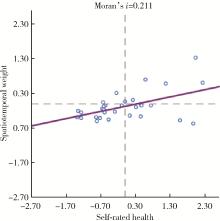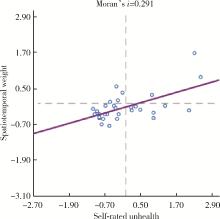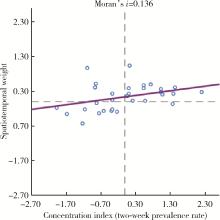Journal of Peking University (Health Sciences) ›› 2024, Vol. 56 ›› Issue (2): 223-229. doi: 10.19723/j.issn.1671-167X.2024.02.004
Previous Articles Next Articles
Related factors and equity of health status among floating population in China based on geographic information system analysis
Xiaohan LIU1,Fan YANG1,Xindi WANG2,Ning HUANG1,Taozhu CHENG1,Jing GUO1,*( )
)
- 1. Department of Health Policy and Management, School of Public Health, Peking University Health Science Center, Beijing 100191, China
2. Department of Sociology, School of Sociology, Huazhong University of Science and Technology, Wuhan 430074, China
CLC Number:
- R195
| 1 |
程梦瑶.中国流动人口的迁移转变与多元化发展[J].兰州学刊,2021,42(7):120-132.
doi: 10.3969/j.issn.1005-3492.2021.07.008 |
| 2 |
木永跃.流动人口社会风险治理: 理论与路径[J].上海行政学院学报,2021,22(2):91-101.
doi: 10.3969/j.issn.1009-3176.2021.02.010 |
| 3 | Wagstaff A .Poverty and health sector inequalities[J].Bull World Health Organ,2002,80(2):97-105. |
| 4 | 宋全成, 张倩.中国老年流动人口健康状况及影响因素研究[J].中国人口科学,2018,38(4):81-92. |
| 5 |
胡婉侠, 王丽, 王翠连, 等.流动老人自评健康状况及影响因素分析[J].中国农村卫生事业管理,2020,40(9):664-668.
doi: 10.3969/j.issn.1005-5916.2020.09.013 |
| 6 |
何南芙, 普亚姣, 李忠起, 等.中国流动老年人口健康状况影响因素及公平性[J].中国老年学杂志,2021,41(19):4398-4401.
doi: 10.3969/j.issn.1005-9202.2021.19.070 |
| 7 |
Connolly S , O'Reilly D , Rosato M .Increasing inequalities in health: Is it an artefact caused by the selective movement of people[J].Social Sci Med,2007,64(10):2008-2015.
doi: 10.1016/j.socscimed.2007.02.021 |
| 8 | 国家统计局. 中华人民共和国统计法[EB/OL]. [2023-09-30]. https://www.gov.cn/govweb/fwxx/bw/tjj/content_504312.htm. |
| 9 | 黄云, 任国强, 周云波.收入不平等对农村居民身心健康的影响: 基于CGSS2015数据的实证分析[J].农业技术经济,2019,38(3):25-37. |
| 10 | 刘瑞平, 李建新.我国中老年人健康不平等的变化趋势及相关因素分解[J].人口与发展,2022,28(5):43-55. |
| 11 |
梁维萍, 郑建中, 韩颖, 等.健康与卫生保健的公平性及其测量方法评介[J].中国农村卫生事业管理,2007,27(10):742-744.
doi: 10.3969/j.issn.1005-5916.2007.10.007 |
| 12 | 任国强, 胡梦雪.跨省流动人口健康自评状况及其影响因素分析: 基于2014年全国流动人口动态监测调查数据[J].中国卫生事业管理,2021,38(8):587-593, 625. |
| 13 | 薛利, 马天佩, 张文婕.城市新移民自评健康状况及其影响因素分析[J].中华疾病控制杂志,2018,22(11):1168-1172. |
| 14 | 潘竞虎, 张佳龙, 张勇.甘肃省区域经济空间差异的ESDA-GIS分析[J].西北师范大学学报(自然科学版),2006,42(6):83-87. |
| 15 | 薛莉萍, 范慧, 郭静.流动人口健康教育现状及其影响因素研究[J].中国健康教育,2017,33(9):771-774, 796. |
| 16 | Lu Y , Qin L .Healthy migrant and salmon bias hypotheses: A study of health and internal migration in China[J].Soc Sci Med,2014,102(4):41-48. |
| 17 | 李雨潼.中国老年流动人口特征及社会融入分析[J].社会科学战线,2021,44(3):270-275. |
| 18 | 张玲玲.上海金山区中学生2012与2017年日常饮食和缺乏体力活动行为比较[J].中国学校卫生,2019,40(6):913-916. |
| 19 | 段成荣, 谢东虹, 吕利丹.中国人口的迁移转变[J].人口研究,2019,43(2):12-20. |
| 20 | 李佳.基于差异性的流动人口社会融合研究[J].东南学术,2021,34(1):106-112. |
| 21 | 张检, 蔡金龙, 何中臣, 等.我国流动人口健康教育现状及其影响因素分析[J].中国健康教育,2021,37(4):291-296. |
| [1] | Silan AN,Qunyi ZHENG,Kai WANG,Shan GAO. Characteristics and influencing factors of early pain in patients after total knee arthroplasty [J]. Journal of Peking University (Health Sciences), 2024, 56(1): 167-173. |
| [2] | JING Ri-ze, ZHANG Hu-yang, XU Ting-ting, ZHANG Lu-yu, FANG Hai. Study on the efficiency of tertiary public hospitals and its influencing factors in Beijing [J]. Journal of Peking University(Health Sciences), 2018, 50(3): 408-415. |
| [3] | ZHAO Yu-wei,WU Ming. Analysis on status and determinants of outpatient service utilization of rural floating population in Beijing at different residence time [J]. Journal of Peking University(Health Sciences), 2017, 49(3): 476-482. |
| [4] | ZHANG Lei, WU Ming. Analysis on status and determinants of self-treatment of rural floating population in Beijing [J]. Journal of Peking University(Health Sciences), 2015, 47(3): 455-458. |
|





